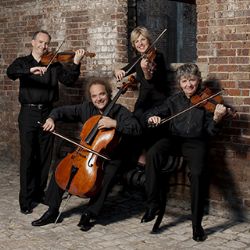|
Symphony
SRS SEASON ENDS WITH RESOUNDING TA-TA-TA-BANG
by Terry McNeill
Sunday, June 1, 2025
Symphony
YOUTHFUL VIRTUOSITY ON DISPLAY AT USO'S MAY CONCERTS
by Peter Lert
Saturday, May 17, 2025
Symphony
MYSTICAL PLANETS AND LIVELY GERSHWIN ORTIZ AT FINAL SRS CONCERT
by Peter Lert
Sunday, May 4, 2025
Symphony
VSO'S CONCERT MUSIC OF TIME, MUSIC OF PLACE
by Peter Lert
Sunday, April 27, 2025
Choral and Vocal
VOCAL ELEGANCE AND FIRE AT THE 222'S RECITAL APRIL 26
by Pamela Hicks Gailey
Saturday, April 26, 2025
CANTIAMO SONOMA SINGS AN INSPIRED GOOD FRIDAY MOZART REQUIEM CONCERT
by Pamela Hicks Gailey
Friday, April 18, 2025
DRAMATIC SHOSTAKOVICH SYMPHONY CLOSES PHILHARMONIC'S 25TH SEASON
by Terry McNeill
Sunday, April 13, 2025
LARGE COLLEGE OF MARIN AUDIENCE GREETS STOPHER ARTISTRY
by Terry McNeill
Saturday, April 5, 2025
Chamber
FRISSON DELIVERS SHIVERS OF DELIGHT
by Abby Wasserman
Sunday, March 30, 2025
OLD AND MOSTLY NEW IN SRS MARCH CONCERT IN WEILL
by Peter Lert
Saturday, March 22, 2025
|
 |
 Takács String Quartet |
FROM HUNGARY WITH LOVE
by Steve Osborn
Sunday, October 27, 2013
The United States is blessed to have dozens of great string quartets in residence, from the upstart Parker, to the mid-career Emerson, to the venerable Guarneri. Few if any of the greats, however, can surpass the Takács String Quartet, which emigrated to the United States from Hungary in 1983 and has been dazzling American audiences ever since.
Currently in residence at the University of Colorado, the quartet has been playing regularly at Cal Performances for many years, and now they have added the Green Music Center in Rohnert Park to their list of stops. Given their performance at the GMC's Weill Hall on Oct. 27, one can only hope they'll return as soon as possible. They were magnificent.
The sight that greeted the audience from the Weill Hall stage was a bit unusual: five chairs instead of the usual four, and a pair of microphones in the middle. The chairs were easily explained, since the Takács was playing quintets, but the microphones remained a mystery until intermission, when one of the GMC's artistic directors explained that they were for people with assisted listening devices, not for amplification.
If ever a group didn't need amplification, it's the Takács. All their players, plus their quintet guests, projected a warm, confident sound, easily filling Weill Hall with sonic glory. The GMC had wisely decided to restrict ticket sales to the ground floor, which was nearly full, and the sound bloomed unobstructed overhead.
Leading the pack was cellist András Fejér, a curly haired benevolent gnome who seemed to meld with his instrument and to center the group. His tone was deep, rich and gorgeous, an unburied treasure for all to hear. His Hungarian compatriot on second violin, Károly Schranz, featured a mop of white hair and a playing style that bordered on the frenetic, constantly bobbing back and forth in time with the music.
Fejér and Schranz are the sole remaining members of the original quartet, founded in 1975. In recent years they have been joined by the restrained but impeccable British violinist Edward Dusinberre and local favorite Geraldine Walther, the former principal violist of the San Francisco Symphony. The changes have been seamless, and all four play together as if they'd been practicing for decades.
Not only was the Takács glorious, but their program was one of a kind: two rarely heard Dvorák quintets, one with an added bass and one with an extra viola. Coming from opposite ends of Dvorák's long career, the quintets display his evolution as a composer, moving from classic European forms to an open American sound.
The bass quintet is one of Dvorák's earliest works, arriving just after his meteoric rise to fame on the strength of his "Slavonic Dances." The work is classic in many respects, from the motivic development of the first movement, to the dance figures of the second, to the rollicking rondo of the finale. It's hard to understand why Dvorák added the bass, which mostly just doubles the cello line; but it does provide some added heft and distinction--How many bass quintets can you name?
Throughout the performance, the Takács and bassist Scott Pingel moved freely but in perfect unison. Dvorák really knows how to hand off melodies, and certain themes moved around the quintet like electric current, flowing from one set of fingers to the next. Of the many transcendent moments, the cello solos in the luscious Andante were the most memorable.
After intermission, the focus shifted to the violas, which doubled in strength thanks to the addition of Erika Eckert, one of the Takács's fellow faculty at the University of Colorado. She opened the unfamiliar "American" quintet (not to be confused with the ubiquitous "American" quartet composed around the same time) with a lovely solo, virtually announcing that the work would dwell on the middle instruments.
Like its famous cousin, the "American" quintet is heavily influenced by Dvorák's famous sojourn in the United States. The first movement is replete with American folk tunes, the second sounds like a barn dance, the third like a church service on the High Plains, and the last like an ebullient outpouring of New World optimism.
Even though she didn't get the opening solo, Geraldine Walther was the absolute star of the quintet, with her soaring tone and compelling lines resonating throughout all four movements. Her solo in the second, with its distinctive quintuplet rhythms, was particularly gripping; while that of the third settled into a luxuriant hymn. Not to be outdone, her plucking duet with Eckert in the finale was a model of rhythmic intensity.
The ovation was long and sustained, but sadly there was no encore--unless the GMC brings them back.
|
